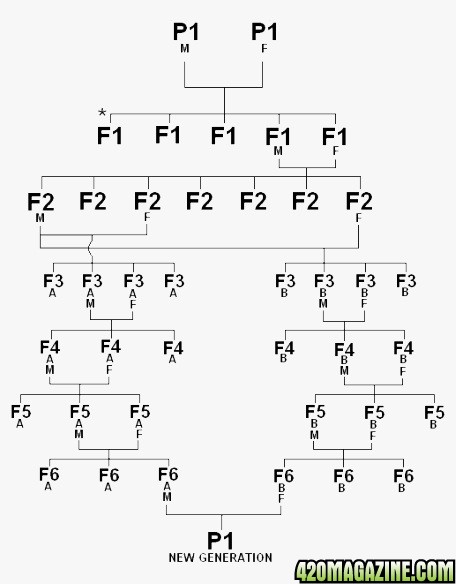Hybrid Garden;2563113 said:So we purchased some seeds from our local seedbank and grown them out. The plants look exceptional and you have good feelings. You decide that you might make some seeds "just in case".
In this theoretical example we bought a pack of 5 seeds. There are 3 females and 2 males. Take the pollen from the males and pollinate a lower branch on each female. Make sure you label the branch so you know which male pollinated it.
After harvest you consider the strain to be exceptional. You have carefully harvested your seeds and now have 6 little jars in front of you, 2 matings for each of the 3 females.
Take the seeds from the female that you liked best and make a choice as to which male you think is better. At this point it makes no difference so either will do. After making your selection put the other jars of seed into long term storage.
The following diagram depicts a simple method to develop your own In Bred Line ( IBL). An IBL is where close sibling breeding is used to stabilize a strain and try to make it breed "true".

** Just a side note to add that it could be possible to replace the males in the above diagram with sex reversed females. I believe the Y gene from the male plays an important part in any serious breeding program but that is only my personal opinion.
The F1 Generation
The seeds in the jar represent our F1 generation. We now grow these plants out. Then just follow the same procedure using at least 3 females and 2 males. You want to produce at least 100 seeds per mating but more is good.
Select the seeds from the best female and put the others into long term storage.
If at this point you felt the F1 plants weren't as good as the parents (P1), an option would be to grow the seeds from the other P1 male to see if that cross produces better results.
Why am I putting all these seeds into storage?
Because sometimes things don't go like they should. The object of breeding should be improvement and the moment your line starts to decline you are moving in the wrong direction. Saving seeds will enable you to go back one or two generations to take a different approach should you need to.
The other thing is any of these can be used to make more IBL's, there are no rules and the possibilities are endless.
It's also important to keep your seeds in order and keep detailed records.
The F2 Generation
This generation is exciting in that you will get recessive genes that have combined and some plants will show traits which were not visible in the previous two generations. There can be some wonderful surprises found hiding amongst these plants.
Now we are going to split our breed into two separate lines. Pick two females which closest resemble the original P1 female and pollinate them with the same male. These seeds will become your F3/A and F3/B seed lines.
F3 to F6 Generations
Just keep doing what we have been doing and select the plants which mostly resemble the P1 plants. If you are doing well your A line plants will be very similar in looks to your B line plants.
P1 New Generation
As you have bred through your generations you will possibly find that there is a decrease in vigor. By crossing our two F6 lines we create hybrid vigor by out crossing, but it's to a strain which is nearly identical in genetic make up.
If everything has gone according to plan we have P1 New Generation plants which are very uniform in growth and appearance which look like the original P1 parents.
Congratulations, you now have a stable line which will breed "true".
Navigation
Install the app
How to install the app on iOS
How To Use Progressive Web App aka PWA On 420 Magazine Forum
Note: This feature may not be available in some browsers.
More options
You are using an out of date browser. It may not display this or other websites correctly.
You should upgrade or use an alternative browser.
You should upgrade or use an alternative browser.
Breeding for Seeds - Hybrid Vigour vs Stabilizing the Strain
- Author Rascio
- Create date
Blog entry information
More entries in Member Blogs
-
Is Cannabis Market Transforming into a Fast-Moving Consumer Goods (FMCG) Sector?Traditionally, the global cannabis consumption market was viewed mainly as a raw material...
-
The Rise of Skate Vape: A New Design Trend in Cannabis ConsumptionAs the cannabis vaping market continues to evolve, new product trends are emerging that push the...
-
Why the Vape with Screen is Gaining Popularity in Cannabis?The cannabis vaporizer industry is evolving rapidly, and one trend that has gained significant...
-
How to Choose the Right Cannabis Vape with A Screen for YouAs the cannabis industry rapidly evolves, the competition among suppliers has intensified...
-
Why Are More Cannabis Brands Introducing Vapes with Screen Display?As the cannabis industry rapidly evolves, the competition among suppliers has intensified...


